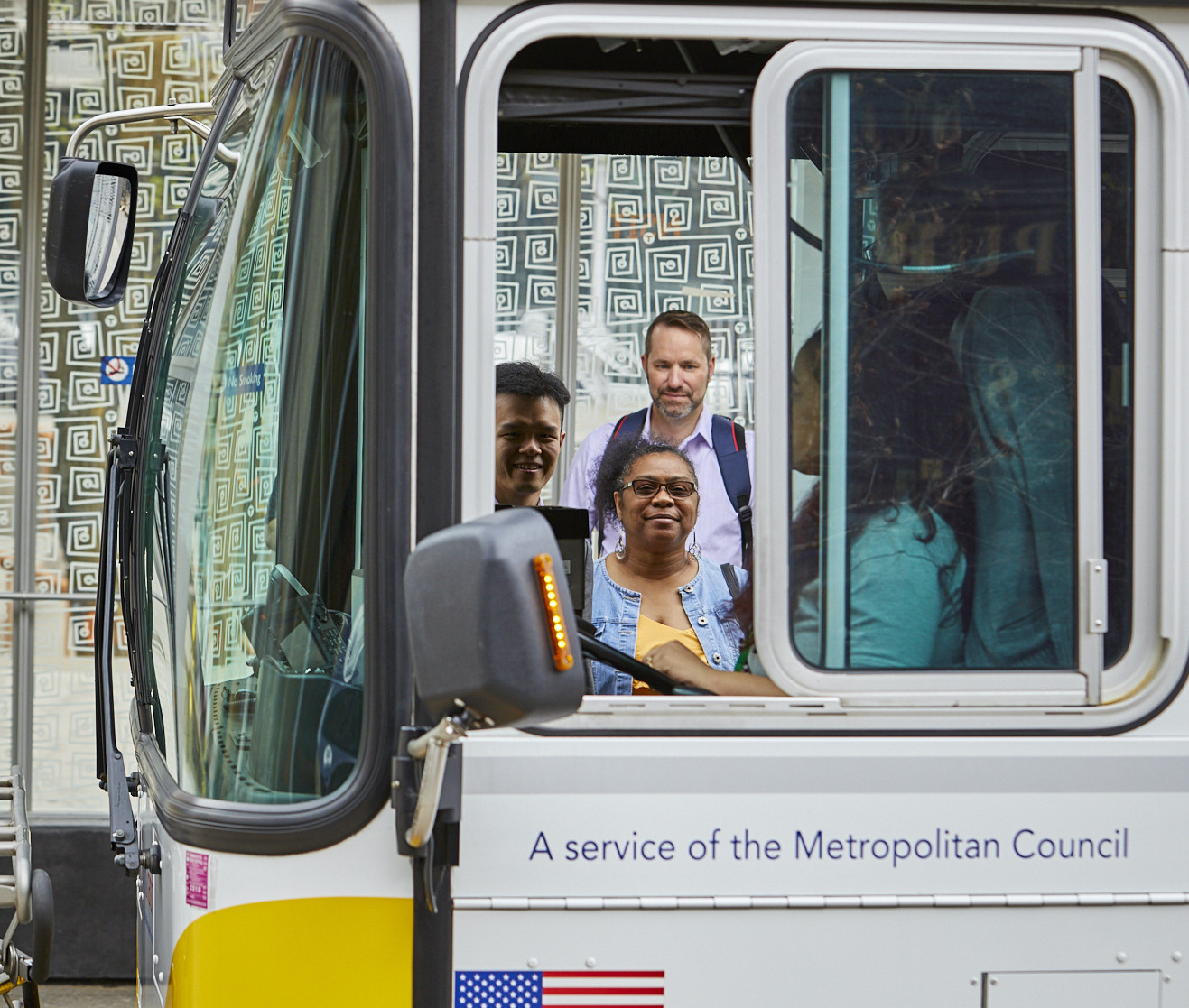
During the COVID-19 outbreak, the decisions transit agencies make in response to the crisis have profound implications for public health and well-being. They must mobilize quickly to prevent crowding, re-allocate service, and protect transit workers and riders from exposure.
The racial disparities in the impact of COVID-19 have underscored the importance of prioritizing social equity in all these decisions. Agencies that treat equity and inclusion as core values to guide their practices will be best positioned to respond effectively during and after the emergency. In this post, we examine Metro Transit in the Twin Cities as a case study in how to embed equity throughout agency decision-making.
Public transit agencies across the United States are increasingly recognizing the need to advance social equity through service provision, capital investment, and small business contracting practices. Less publicized — but no less important — are internal practices to advance social equity within the transit agency workplace itself.
Equitable decision-making inside agencies is foundational to making equitable public-facing policy. An agency workforce that fully represents the identities and experiences of its ridership is more likely to make service and planning decisions that yield more equitable social and economic outcomes. The status quo falls far short: Most transit riders are women, people of color, and people with low incomes, while there is typically a gender imbalance throughout transit agency ranks and a lack of people of color at leadership levels. And yet, promoting diversity, equity, and inclusion within the transit workplace is rarely discussed in much detail.
What can transit agencies do to embed equity as a core principle in internal practices, and how may that affect external practices? Metro Transit in the Twin Cities region offers a model. The agency’s Equity and Inclusion Department has operationalized equity in meaningful ways, creating paths for more diverse voices to contribute to important agency decisions.
Embedding Equity in the Institution
The Equity and Inclusion Department originated in 2014, when the Metro Council (the Twin Cities’ regional planning agency) adopted equity as a core goal in its 30-year plan, which was the result of a robust and inclusive public engagement process. Metro Transit, which reports to the Metro Council, established a “change team” to make the agency a more representative and equitable institution.
Today the Equity and Inclusion Department is staffed by three full-time employees who work closely with 11 other employees from across the agency. The department reports to the Senior Manager for Policy Development, who reports to the General Manager. From this vantage point, the department is well-positioned to influence major Metro Transit decisions. (Previously it was nested in the marketing department — the change was implemented as part of an agency restructuring in 2019.) The 11 employees who coordinate with the Equity and Inclusion Department are known as the Equity and Inclusion team. They work in close partnership with the department’s three dedicated staff members, advising how to advance equity within the workplace and with the broader public.
The team members represent various divisions and functions within Metro Transit — vehicle operators, mechanics, police, marketing, customer service, and so on. They are selected through an application process and retain their full-time roles as they take on additional responsibilities for the Equity and Inclusion team.
The selection process determines whether applicants can connect and commit to the important work of embedding equity within the agency’s practices. They answer a series of questions about how they implement equity and inclusion in their daily work and lives, and how Metro Transit can become an inclusive workplace and provide equitable access to opportunity for both employees and riders.
Team members are seen as leaders — they are models to other employees of what it means to practice and embody equity and inclusion in daily work activities. They meet every two weeks to plan initiatives and special events that enhance Metro Transit’s ability to identify and address inequities.
For instance, when bus operators on the Equity and Inclusion team noticed that people in the neighborhoods they live in and drive through weren’t signing up for Metro Transit’s low-income fare program — known as TAP — the team began organizing to spread the word. The team worked with the TAP coordinator to get trained in signing people up for the program. They set out to determine which communities would benefit most from additional outreach efforts, and how to establish partnerships with local community organizations to enroll more people.

One partnership arose from the relationship between a Metro Transit bus operator on the Equity and Inclusion team and a regular rider, said Sarah Berres, program specialist with the Equity and Inclusion Department. “Our operator, while out on their route, was able to talk to this rider every day and make that connection to move forward the referral process, so that the Metro Transit TAP coordinator could formally add the organization as an official TAP referral partner.”
The story highlights the interplay of internal practice and external impact. Metro Transit empowered frontline agency staff, and frontline staff increased enrollment in the TAP initiative, improving transit access for people who were eligible for TAP but hadn’t signed up before.
The team also provides important perspective to the General Manager and other senior staff as internal agency protocols are shaped. When the Metro Council reviewed the agency’s policies for new parents in the workforce, for instance, the Equity and Inclusion team assessed the need for and availability of private mothering rooms in Metro Transit staff facilities, and researched best practices to implement safe and secure rooms for new parents.
“The research was led by our Equity and Inclusion team getting out on the ground, looking and taking photos of all the spaces, following a checklist they created to rate all of the different rooms,” said Berres. “The team was really able to utilize tons of data and research to help influence how things moved forward.” As a result, a number of private mothering rooms were upgraded; Metro Transit assigned a staff member to continue evaluating these rooms on an ongoing basis; and now, when the agency moves into new buildings or renovations are made, these private rooms are seen as essential elements of what the facilities should include.
Uncharted Waters
Emphasizing equity as a guiding principle is a new approach for many public transit agencies. But this does not mean agencies must start from scratch.
When first developing its equity and inclusion initiative, Metro Transit looked to other local government offices in the Twin Cities and other transportation agencies. To connect with peers, Metro joined a national network of public sector agencies called the Government Alliance on Race and Equity (GARE). GARE coordinates regional cohorts of public agencies and shares best practices, generating a collective impact to institutionalize racial equity in municipal government.
Metro Transit also looks inward to take stock of where equitable practices are already embedded within the agency, and how those practices can be expanded. For instance, the Equity and Inclusion team determined that the agency’s service planners have a robust public engagement approach. Information from these workshops and surveys informs the Equity and Inclusion team’s own decisions and the policy agenda it develops with service planners.
The Equity and Inclusion team at Metro Transit recognizes that promoting equity is not a task that can be checked off a to-do list. Equity must be embedded from the outset of every initiative a transit agency takes on. Without a workforce that itself is representative, engaged, and empowered, the goal of connecting Twin Cities residents to opportunities through equitable transit service would be much more difficult to accomplish.
Such transformational work takes time and dedication, as well as trust and buy-in from people from different backgrounds throughout the agency. Metro Transit’s approach to equity and inclusion demonstrates how to initiate this process and give the staff members entrusted to carry it out what they need to make an impact. By seeking expertise from employees across agency divisions, and ensuring their ideas come to fruition, Metro Transit is building a diverse slate of engaged decision-makers within the agency’s ranks.

 On the Brink: Will WMATA’s Progress Be Erased by 2024?
On the Brink: Will WMATA’s Progress Be Erased by 2024?
The experience of being a WMATA rider has substantially improved over the last 18 months, thanks to changes the agency has made like adding off-peak service and simplifying fares. Things are about to get even better with the launch of all-door boarding later this fall, overnight bus service on some lines starting in December, and an ambitious plan to redesign the Metrobus network. But all of this could go away by July 1, 2024.
Read More To Achieve Justice and Climate Outcomes, Fund These Transit Capital Projects
To Achieve Justice and Climate Outcomes, Fund These Transit Capital Projects
Transit advocates, organizers, and riders are calling on local and state agencies along with the USDOT to advance projects designed to improve the mobility of Black and Brown individuals at a time when there is unprecedented funding and an equitable framework to transform transportation infrastructure, support the climate, and right historic injustices.
Read More